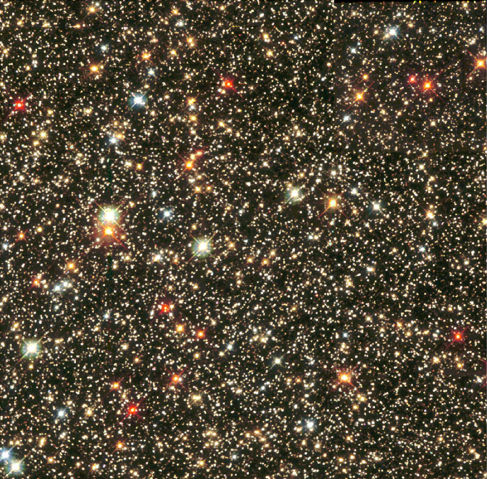11.1 Classification by Colour
Look at the beautiful picture of the stars in the Sagittarius Star Cloud shown in Figure 11.1. The stars show a multitude of colours, including red, orange, yellow, white, and blue. As we have seen, stars are not all the same colour because they do not all have identical temperatures. To define colour precisely, astronomers have devised quantitative methods for characterizing the colour of a star and then using those colours to determine stellar temperatures. In the chapters that follow, we will provide the temperature of the stars we are describing, and this section tells you how those temperatures are determined from the colours of light the stars give off.
Sagittarius Star Cloud

The Sagittarius Star Cloud: A Sky Full of Glittering Jewels by Hubble Heritage Team (AURA/STScI/NASA)), NASA Media License.
Blue colours dominate the visible light output of very hot stars (with much additional radiation in the ultraviolet). On the other hand, cool stars emit most of their visible light energy at red wavelengths (with more radiation coming off in the infrared) Table 11.1 shows star colours and their corresponding temperature. The colour of a star therefore provides a measure of its intrinsic or true surface temperature (apart from the effects of reddening by interstellar dust).
“Cosmic Latte” or the Average Colour of Stars

The Average Color of the Universe by Karl Glazebrook & Ivan Baldry (JHU), NASA Media License.
Colour does not depend on the distance to the object. This should be familiar to you from everyday experience. The colour of a traffic signal, for example, appears the same no matter how far away it is. If we could somehow take a star, observe it, and then move it much farther away, its apparent brightness (magnitude) would change. But this change in brightness is the same for all wavelengths, and so its colour would remain the same.
| Star Colour | Approximate Temperature | Example |
|---|---|---|
| Blue | 25,000 K | Spica |
| White | 10,000 K | Vega |
| Yellow | 6000 K | Sun |
| Orange | 4000 K | Aldebaran |
| Red | 3000 K | Betelgeuse |
The hottest stars have temperatures of over 40,000 K, and the coolest stars have temperatures of about 2000 K. Our Sun’s surface temperature is about 6000 K; its peak wavelength colour is a slightly greenish-yellow. In space, the Sun would look white, shining with about equal amounts of reddish and bluish wavelengths of light. It looks somewhat yellow as seen from Earth’s surface because our planet’s nitrogen molecules scatter some of the shorter (i.e., blue) wavelengths out of the beams of sunlight that reach us, leaving more long wavelength light behind. This also explains why the sky is blue: the blue sky is sunlight scattered by Earth’s atmosphere.
Attribution
“17.2 Colours of Stars” from Douglas College Astronomy 1105 by Douglas College Department of Physics and Astronomy, is licensed under a Creative Commons Attribution 4.0 International License, except where otherwise noted. Adapted from Astronomy 2e.

